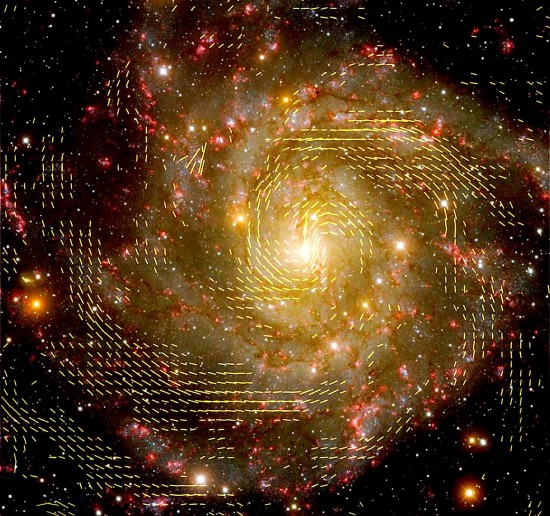
Galaxy IC 342, using data from the VLA and the Effelsberg telescope, showing the orientation of magnetic fields. Credit: R. Beck, MPIfR; NRAO/AUI/NSF; graphics: U. Klein, AIfA; Background image: T.A. Rector, University of Alaska Anchorage and H. Schweiker, WIYN; NOAO/AURA/NSF.
Jun 24, 2015
Galactic magnetic fields continue to be a mystery.
Recently, astronomers using the National Science Foundation’s Karl G. Jansky Very Large Array (VLA), and the MPIfR’s 100 meter Effelsberg radio telescope in Germany observed galaxy IC 342. Both of the radio telescopes’ capabilities were merged in order to uncover the galaxy’s magnetic field, which appears denser in its spiral arms. The announcement states that they were “surprised” to find a “huge, helically-twisted loop coiled around the galaxy’s main spiral arm…” Such a feature, never before seen in a galaxy, supports Electric Universe theory.
Consensus science has difficulty explaining galactic magnetic fields. Most of the theoretical background available to them contains nothing based on electricity that can provide a source for that magnetism. No electromagnetism, no electric fields, and no motor-generator effects are included in their calculations. Cool gas falling into galaxies, supernovae explosions, star birth, and rotational energy are their only options, although those concepts are not able to predict the observed magnetic fields.
It is the movement of electric charges that create magnetic fields: there is no other way for them to form, despite some popular online videos that feature devices using “magnetism without electricity”. Modern astronomers believe that the fields they detect are “primordial” fragments left over from the Big Bang, “frozen-in” to near-superconducting plasma, even though the fact that moving charges constitute an electric current that can generate magnetic fields has been known since the days of Michael Faraday. When charged particles move they generate electricity and that electric current is wrapped in a magnetic field. When more charged particles accelerate in the same direction, the field gets stronger.
For charged particles to move, they must move in a circuit. The consensus scientific opinion only permits isolated “islands” in space, however. Electric Universe theory, on the other hand, emphasizes connectivity with an electrically active network of Birkeland current filaments. In Hannes Alfvén’s, Cosmic Plasma, Birkeland currents (“plasma cables”) are described as follows:
“Plasma cables seem to be reasonably stable formations which can be considered as structures important for the understanding of plasma phenomena. (Of course, their interior structure should be described by classical theory.) The plasma cables are either filaments or ‘flattened filaments’ (sheets with limited extent). They carry an electric current parallel to the magnetic field, and this is what gives them their properties. The cables are often very efficient in transferring electromagnetic power from one region to another.”
Filaments expand and explode, throwing off plasma that can accelerate to nearly the speed of light. Jets from opposite poles of a galaxy end in energetic clouds emitting X-ray frequencies. Those phenomena are based in plasma science and not gas kinetics, gravity, or particle physics. Astrophysicists see magnetic fields but not the underlying electricity, so they are at a loss to explain them.
Even though no black hole has ever been observed, since galaxies are collections of gas and intergalactic dust assembled by gravity in conventional theory, it is also assumed that they contain black holes of unbelievable magnitude. It is those “gravity motors” that are said to cause galaxies to spin, for jets of gamma and X-rays to appear, and for “radio lobes” sometimes larger than the parent galaxy to form.
The newly discovered larger magnetic fields around IC 342’s spiral arm are no surprise to Electric Universe advocates. As mentioned, galaxies are part of an electric circuit interconnecting the cosmos. Electricity organizes masses of plasma sometimes larger than galaxy clusters. That plasma is primarily composed of neutral atoms, but free electrons, protons and other charged particles are also present, inducing electric power orders of magnitude more powerful than gravity.
Stephen Smith












